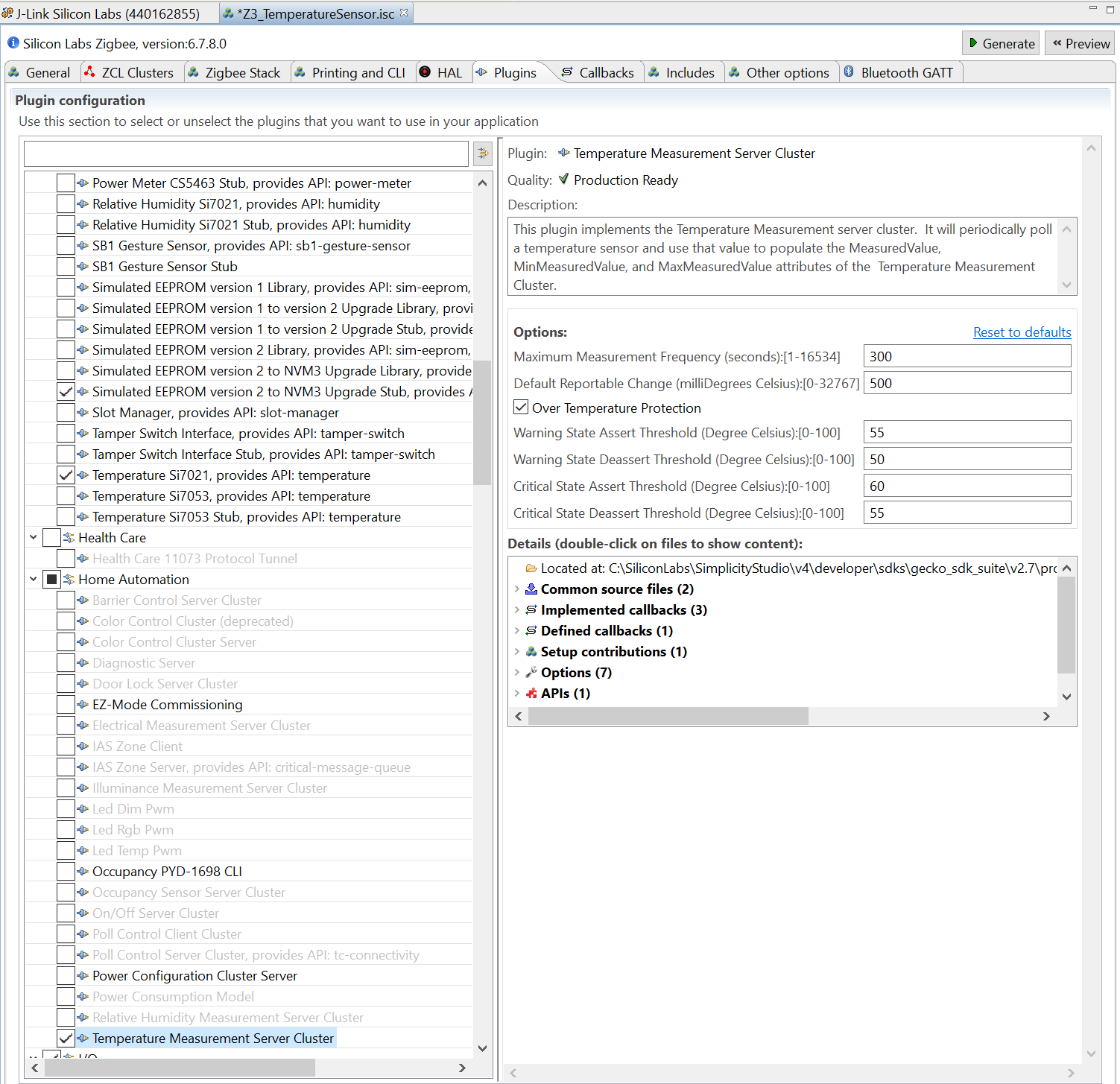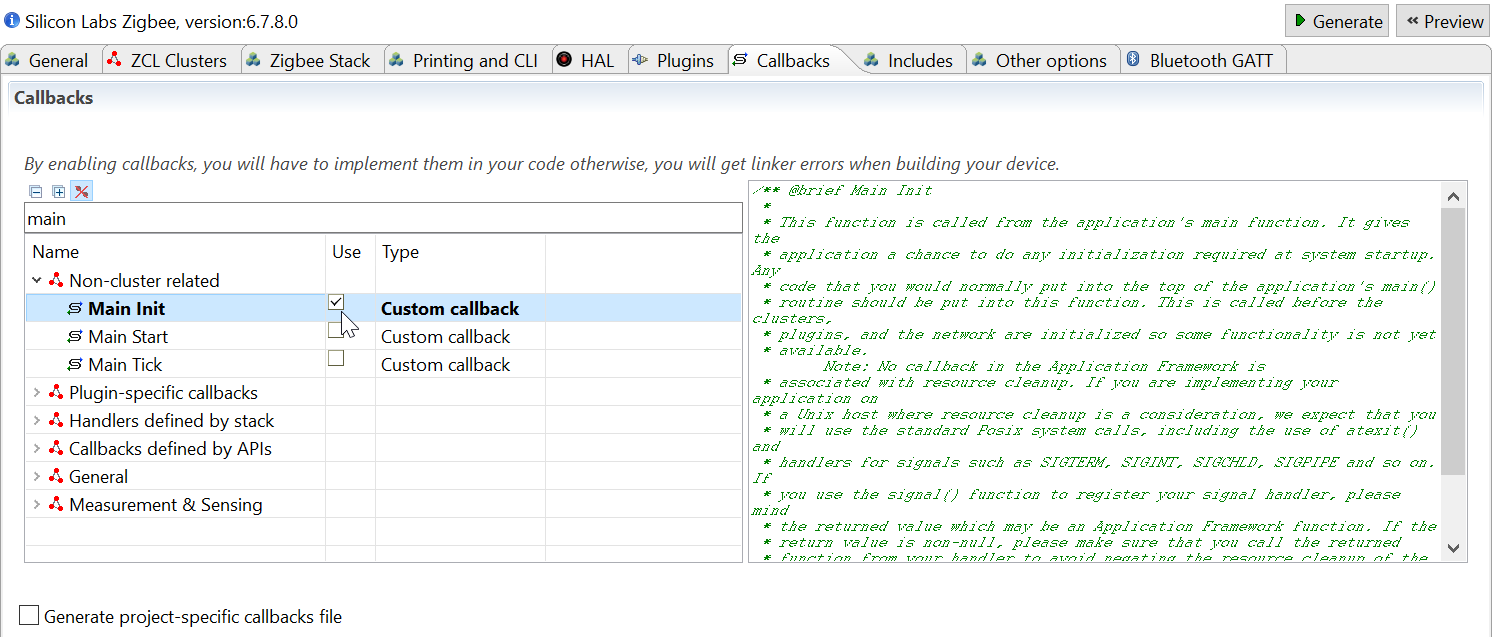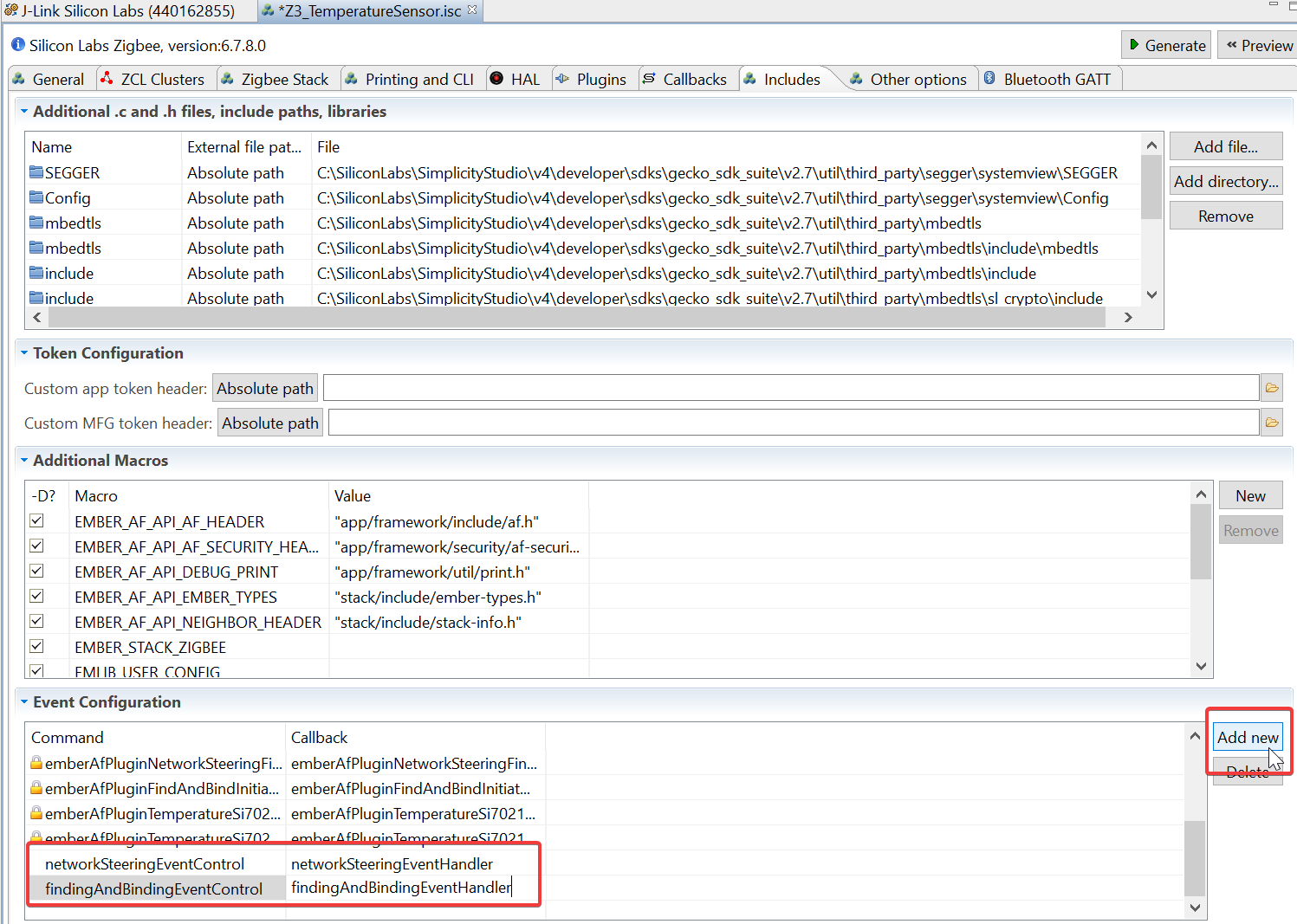Implement your application
Silicon Labs App Builder projects have a very specific way of being implmented:
- Plugins are provided, and bring sources in the project that cover basic implementations for you
- Stack and Plugins both define Callback functions that allow you to implement event driven algorithms
Be careful:
- A lot of code is generated or linked according to your ZCL and Plugin configurations
- Callback stub function definitions are handled by Appbuilder - letting you responsible of implementing the functions you selected
Consequently, your Appbuilder based application implementation is going to be split into 2 main parts, the Plugins & Callbacks implementation, and your own code.
Plugins Callbacks and Events
Plugins
Through the "Plugin" tab, add thefollowing plugins (use the search bar to find it):
-
Network Steering
Used to join networks -
Update TC Link Key
Used to join Zigbee 3.0 centralized networks -
Reporting
Used to send periodic attribute reports Note that accuracy of reporting is relying on the LF clock source used (LFRCO, PLFRCO, LFXO) -
I2C Driver
Used to implement I2C for Si7021 communication -
Temperature Si7021
Driver implementation for the Si7021 (present on Thunder Board Sense boards) -
Temperature Measurement Server Cluster
Implementation of ZCL Temperature Measurement Server Cluster This allows you to simply edit the plugin options and not waste time implementing any of it -
Zigbee PRO Leaf Library
Lightened Zigbee PRO Library for End Devices use only -
Find and Bind Initiator
Used to bind our device to a dicoverable Temperature Measurement Client Mandatory as reportings only work using bindings - per spec -
Idle/Sleep
Used to bring the device down to EM2 -
Identify Cluster
-
Heartbeat
Blinks an LED to display stack status (only applicable when deep sleep is disabled)

Callbacks
Through the "Callbacks" tab, add the following functions (use the search bar to find it):
- Main Init
Will be used to add extra init code - Complete (Network Steering)
- Complete (Find And Bind Initiator)
- Hal button ISR
- Ok To Sleep

Custom Software Events
Finally, to safely link hardware events (i.e. button presses) to network or application actions (i.e. network joining, force sending reports) we need to declare Events in the ISC This is done through the "Includes" tab of the ISC file, in the last section named "Event Configuration"
There add 2 new events:
-
networkSteeringEventControl networkSteeringEventHandler -
findingAndBindingEventControl findingAndBindingEventHandler

All of the previous applies only when you click the "Generate" button on top of the ISC file
C Implementation
Now that our project has its Plugins added, we will need to implement callback functions as well as events By default, all callback implementations go to project_name_callbacks.c file We will work there in this example
- Add the following lines at the top of the file:
#include EMBER_AF_API_NETWORK_STEERING
#include EMBER_AF_API_FIND_AND_BIND_INITIATOR
#include "em_gpio.h"
#define TEMPERATURE_MEASUREMENT_ENDPOINT (1)
EmberEventControl networkSteeringEventControl;
EmberEventControl findingAndBindingEventControl;
void networkSteeringEventHandler(void);
void findingAndBindingEventHandler(void);
static void scheduleFindingAndBindingForInitiator(void);
static bool commissioning = false;
static uint8_t lastButton;
- Edit the emberAfMainInitCallback implementation so that it looks like this:
void emberAfMainInitCallback(void) {
GPIO_PinModeSet(BSP_I2CSENSOR_ENABLE_PORT, BSP_I2CSENSOR_ENABLE_PIN, gpioModePushPull, 1);
}
This powers up the Si7021
- Implement the HAL Button ISR so it triggers an network steering (Joining):
void emberAfHalButtonIsrCallback(uint8_t button,
uint8_t state)
{
if (state == BUTTON_RELEASED) {
lastButton = button;
emberEventControlSetActive(networkSteeringEventControl);
}
}
- Edit the networkSteeringEventHandler as follows:
void networkSteeringEventHandler(void)
{
EmberStatus status;
emberEventControlSetInactive(networkSteeringEventControl);
if (emberAfNetworkState() == EMBER_JOINED_NETWORK) {
if (lastButton == BUTTON0) {
//To be programmed with something
} else if (lastButton == BUTTON1) {
//To be programmed with something
}
} else {
status = emberAfPluginNetworkSteeringStart();
emberAfCorePrintln("%p network %p: 0x%X",
"Join",
"start",
status);
commissioning = true;
}
}
If the device is not joined to a network, this will trigger a Network steering procedure Otherwise nothing (anything else can be coded) Note that we declared a static commissioning variable so that the full joining proces covers both steering and binding
- Finally, implement the Network steering Complete callback so it triggers a find and bind:
void emberAfPluginNetworkSteeringCompleteCallback(EmberStatus status,
uint8_t totalBeacons,
uint8_t joinAttempts,
uint8_t finalState)
{
emberAfCorePrintln("%p network %p: 0x%X", "Join", "complete", status);
if (status != EMBER_SUCCESS) {
commissioning = false;
} else {
scheduleFindingAndBindingForInitiator();
}
}
- Implement the forward declared schedule find and bind function:
static void scheduleFindingAndBindingForInitiator(void)
{
emberEventControlSetDelayMS(findingAndBindingEventControl,
200);
}
We do that to let time to the stack to initiate networking operations first
- Also, edit the find and bind event handler:
void findingAndBindingEventHandler(void)
{
emberEventControlSetInactive(findingAndBindingEventControl);
EmberStatus status = emberAfPluginFindAndBindInitiatorStart(TEMPERATURE_MEASUREMENT_ENDPOINT);
emberAfCorePrintln("Find and bind initiator %p: 0x%X", "start", status);
}
This starts a find and bind procedure on the 1st Endpoint In this example it is fixed, but you can have it changed at runtime as long as your local endpoint exists
- Finally implement the find and bind complete to close the full joining procedure:
void emberAfPluginFindAndBindInitiatorCompleteCallback(EmberStatus status)
{
emberAfCorePrintln("Find and bind initiator %p: 0x%X", "complete", status);
commissioning = false;
}
At this stage, network joining is complete and working
- In order to use the CLI, we will disable low power by implementing the Ok To Sleep function so it returns false :
bool emberAfPluginIdleSleepOkToSleepCallback(uint32_t durationMs)
{
return false;
}
- Build and flash the generated binary (do not forget to flash a bootloader) on your kit.